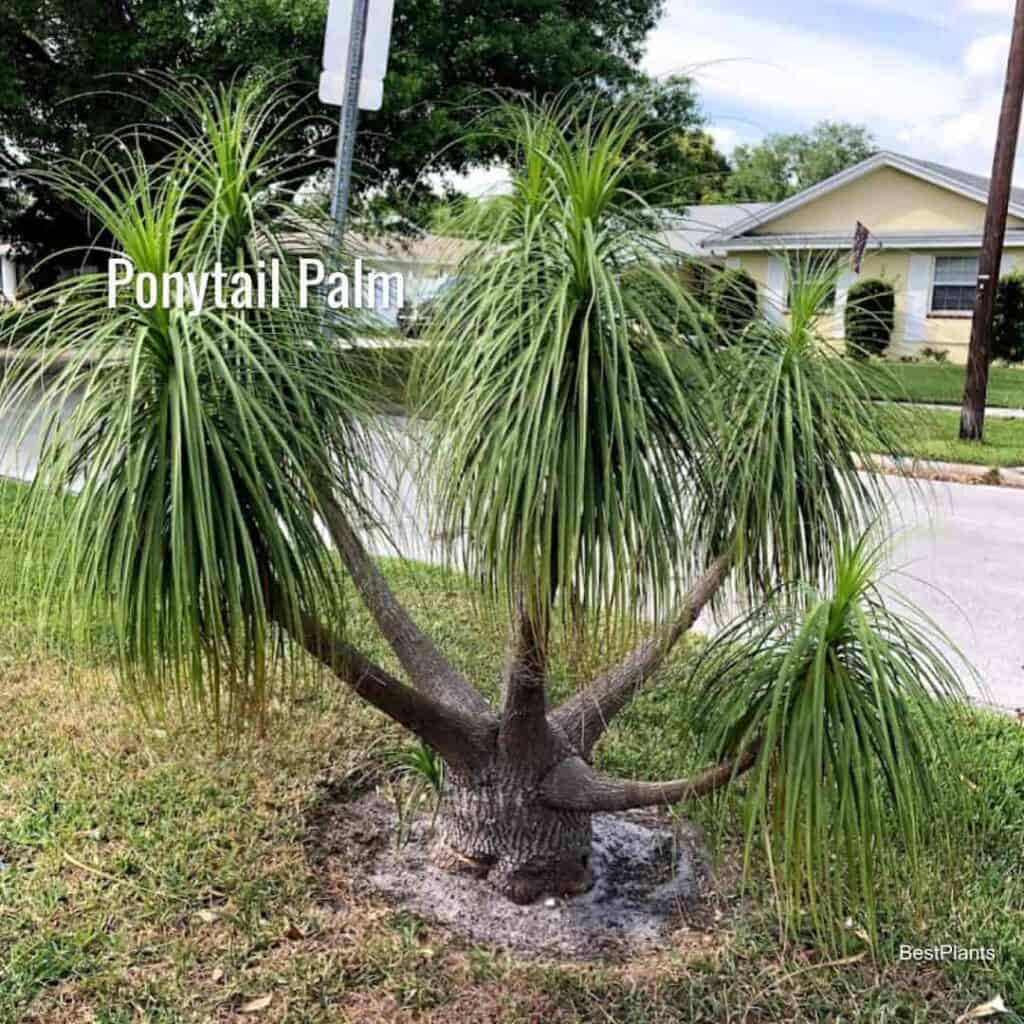Beaucarnea recurvata, also known as Nolina recurvata, is a beautiful household shrub with a distinctive shape.
Its foliage is curved back like a fountain, while its trunk is swollen near the base.

Beaucarnea recurvata [bow-KAR-nee-uh] [rek-er-VAY-tuh] isn’t a palm tree like the name suggests.
It’s a dioecious succulent that stores water in its stem, forming a caudex.
It originates from the semi-desert areas of southeast Mexico and belongs to the Asparagaceae family.
It’s also known as:
- Elephant’s Foot Tree
- Bottle Palm
- Bottle Ponytail
The Ponytail Palm is also an evergreen perennial tree that keeps its shape for years.
The foliage of the tree is arranged in tufts giving it the shape of a crown, a ponytail, or a fountain.
Its leaves are also thin, soft, and leathery.
To learn more about Ponytail Palm care, keep reading on.
Ponytail Palm Care
Size And Growth
Beaucarnea recurvata can grow up to 30’ feet tall, and the base can grow up to 12’ feet wide when planted outdoors.
When planted indoors, it would only grow up to 3’ feet in suitable conditions.
It’s a slow-growing tree that can only grow up to 11” inches per year and much less when planted in a pot.
The growth of the plant could be completely inhibited by the use of a small pot that only fits the size of the stem.
Flowering And Fragrance
Although Ponytail Palm is originally a flowering plant, it doesn’t usually grow flowers indoors.
That is caused by the lack of space and unfavorable weather.
When grown outside or in a large enough pot, it can produce scentless pink or ivory flowers depending on their gender.
However, it could take up to 20 years after planting the tree to see those beautiful flowers blooming.
In regards to fragrance, the green foliage of Ponytail Palm doesn’t have a distinguishable scent.
Light Conditions And Temperature
Ponytail Palm favors hot temperatures and direct sun due to its native environment being a desert region.
You could grow them in full direct sunlight without a problem.
Placing it near a west window, where sunlight is abundant, is a great choice.
You could also leave it in a semi-shade area, but it won’t grow as fast.
In regards to the ideal temperature, ponytail palm prefers temperatures between 60° and 80° degrees Fahrenheit, which is the ideal room temperature.
It is also best to grow it in semi-dry conditions away from high humidity.
Watering And Fertilizing
Since beaucarnea recurvata is a succulent plant, it doesn’t require frequent watering.
Its roots grow deep into the soil, collecting, transporting, and storing the water in its base.
It can go for up to 4 weeks without water, but it’s preferable to water it every 2 weeks.
Always check that the soil is at least 1” inch dry before watering the plant.
During spring, you could feed the plant liquid fertilizers every 2 to 4 weeks to enhance the growth of the plant.
Soil And Transplanting
Ponytail Palm trees aren’t picky when it comes to the type of soil they grow in.
They could grow well in standard planting soil with good drainage.
A better option is a 7:3 soil mixture of regular planting soil and pumice or perlite.
That type of soil allows for good water drainage and healthier roots.
Here are some of the tips to remember:
- Avoid repotting it right after purchase.
- Give it at least a year before moving it to a larger pot.
- When replanting in a bigger pot, be aware that the pot has to be slightly larger than the previous one.
You don’t want the soil around the roots to retain water for a long time.
If that happened, it might cause the roots to rot or propagate fungus infections and other diseases.
Make sure that the container you’re transplanting to has multiple drainage holes at the bottom.
Grooming And Maintenance
Ponytail Palm doesn’t require much maintenance or grooming.
However, during the growth season, you could do the following steps:
- Carefully trim the dry, thin parts of the leaves.
- Cut the plant in a smooth or a slightly round cut to allow the plant to grow again.
- If you encounter any surfaces that turn brown after cutting, apply pruning paint to that cut part right away.
How To Propagate Ponytail Palm?
You could grow Ponytail Palm from seeds, but it’s a difficult process that takes a very long time.
You could also try to propagate it using a cut stem.
More often than not, the stem won’t grow roots, and it will rot.
A perfect method to propagate Ponytail Palm is by waiting for it to produce new stems from the soil.
When it does that, wait until they become at least an inch tall with a grown base.
Then, carefully place that new stem in a small pot with a good drainage system.
Ponytail Palm Pest And Disease Problems
There are a few reasons why Ponytail Palm trees could catch pests or disease:
- Not subjecting them to enough sunlight.
- Placing them in a humid area.
- Overwatering them.
- Having low-drainage soil.
- Being planted in an overly large pot.
These conditions subject your plant to pests, including:
- Spider mites
- Scale insects
- Mealybugs
When faced with any of these insects, you could either spray them with a systemic insecticide or use water to wash them off.
If you’re resorting to the water wash, make sure that you’re covering the base of the plant with a plastic bag to avoid overwatering it.
Uses For Ponytail Palm
Ponytail Palm is often used indoors as an ornamental household plant.
It’s used for its unique foliage structure and durable nature.
It’s also a non-toxic plant that you could safely keep around pets and children.